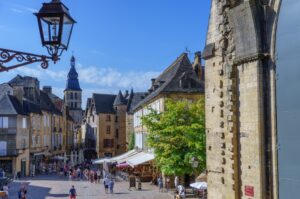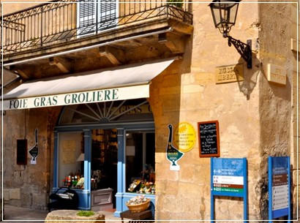In writing about Sarlat, we need to be rather specific. We’re talking about Sarlat-la-Canéda, located in the Dordogne region of France. Names can be a bit tricky in France; there are at least three other villages named Sarlat and the Dordogne is also known by its more ancient name, the Perigord. (We Americans shouldn’t sneer. There are 41 US cities and towns named Springfield.)
The Place de la Liberté in Sarlat. Photo courtesy of Wikipedia.
There are three reasons to visit Sarlat and its environs: architecture, gastronomy and history. The architecture of Sarlat is that of a well-maintained medieval village. Before the French Revolution, Sarlat was a large commercial center but later the trains passed it by, commerce died out and it fell into disrepair. André Malraux, the novelist and Minister of Culture in the 1960’s poured funding into Sarlat for its restoration. Today, visitors can wander narrow cobblestoned streets and view homes and businesses looking much as they did in the 15th century. The focus of interest is the main square, the Place de la Liberté, which is ringed by shops selling things to the tourists, where markets are held on Saturday and Wednesday mornings.
A typical Sarlat foie gras shop. Photo courtesy of Sarlat Tourisme.
There are more than shops on the square and in the town. There is food, often with the most famous products of the region around Sarlat: truffles and foie gras. Dishes served perigourdine are flavored with those back gastronomic diamonds: truffes noires or black truffles. There are other locales in France where truffles are found, not grown. (See Power Tasting’s article about Carpentras.) Truffles go so well with foie gras, and foie gras is really what Sarlat is all about,. You can have it so many ways: sautéed, au torchon, mi-cuit, entier, pâté, terrine. And they’re all for sale in Sarlat’s shops, along with implements like silver knives that looks a bit like coping saws for slicing foie gras and silver spatulas for serving it.
If you travel just outside Sarlat, you can visit farms where they raise the ducks and geese that are used for foie gras. Yes, we know the arguments for the mistreatment of these birds, but from what we’ve seen, they look pretty well taken care of right up to the end. And a flock of geese running around and honking like mad is a natural comedy show.
And as long as you’re traveling outside Sarlat, take in a little of the history of the region. The most ancient on view is at the famous cave at Lascaux, full of prehistoric paintings. Actually, you can’t see the actual cave, because exposure was erasing the artwork. But they have built an exact replica nearby. More recent, there are the châteaux of Beynac and Castelnaud…only 900 years old. They face each other across a broad valley, and during wars of the Middle Ages, they fired back and forth at each other. At Castelnaud you can actually see replicas of the weapons they used in those days.
It isn’t easy to get to Sarlat. It’s almost a three-hour drive from the Bordeaux airport and 2½ hours by train. You can shave off an hour if you start from St. Emilion. However you get to Sarlat, it’s worth the trip.

